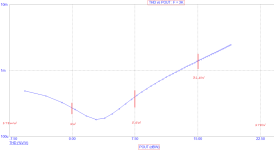However, I would like to refrain from recommending the variant in posting #55.
This thread is intended to show examples of what is possible and where possible adjustments could be hidden.
But I wish you lots of fun and all the best gannaji.
greetings,
HBt.
This thread is intended to show examples of what is possible and where possible adjustments could be hidden.
But I wish you lots of fun and all the best gannaji.
greetings,
HBt.
I would even do without Q8  😉,
😉,
This is where the practical part is hidden - which sound does the customer like best with their loudspeaker and preferred music material?!
 😉,
😉,This is where the practical part is hidden - which sound does the customer like best with their loudspeaker and preferred music material?!
Note
I (sitting in front of the screen and dumbfounded) have fallen prey to a flight of faith:
The THD graphs shown here should of course not simply be automatically equated with 20 = 20 W in x-axis. The power here is referred to a reference power of 1W in the pseudo unit dB, i.e. 10 times log10 of (power/1W).
Apologies for this faux pas, So "Alte Schule",does much, much more than just 36Wpeak into 8 ohms.
With far more than 30Wrms and with predicted THD values far below 10m% - this circuit is now very attractive.
Bye,
HBt.
I (sitting in front of the screen and dumbfounded) have fallen prey to a flight of faith:
The THD graphs shown here should of course not simply be automatically equated with 20 = 20 W in x-axis. The power here is referred to a reference power of 1W in the pseudo unit dB, i.e. 10 times log10 of (power/1W).
Apologies for this faux pas, So "Alte Schule",does much, much more than just 36Wpeak into 8 ohms.
With far more than 30Wrms and with predicted THD values far below 10m% - this circuit is now very attractive.
Bye,
HBt.
Attachments
Why should an audio amplifier design be more complex than it needs to be? Less is definitely more - and the path shown here points to almost unbelievable THD figures, so why not limit yourself to the simplest approach? It's economical and will certainly survive any party unscathed. I am convinced that the “Alte Schule” is a very good hi-fi audio amplifier and has absolutely nothing to hide.
I would be happy to produce a PCB, a layout - for the DIY forum and its enthusiastic members. “Alte Schule” puts every current dumper approach in its pocket.
I would be happy to produce a PCB, a layout - for the DIY forum and its enthusiastic members. “Alte Schule” puts every current dumper approach in its pocket.
